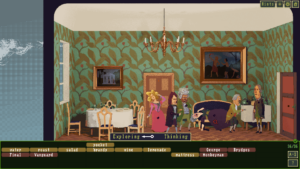Chants of Sennar
I see that Chants of Sennar is now a Hugo finalist. I’ve been meaning to post about it for a little while. I mean, it’s mainly about language puzzles. That puts it right in my wheelhouse. The main thing I want to talk about is the revelations at the story’s ending, but we’ll need to lay some foundations first. Still, I’m going to be pretty free with the spoilers here, and it’s still a new enough game for me to point that out.
So, what we have here is an adventure game where the main challenge is learning the five mini-languages, in five different writing styles, used by five peoples living in a city-sized tower, from the Devotees at the bottom to the Anchorites at the top, as you encounter them one by one over the course of your ascent. The languages are purely written and essentially ideographic; even when a character speaks aloud, their words are displayed on the screen rather than pronounced. Essentially, each civilization and its language forms a chapter of the story, with its own color scheme, although you can always go back and try to pick up vocabulary you missed for 100% completion. And sure, there are other challenges: Mazes to explore, stealth sequences to repeatedly fail at. A Rush Hour puzzle at one point. (I remember when Rush Hour was brand new, and by now it’s found a growing niche as a filler puzzle in adventure games similar to Towers of Hanoi and Lights Out — perhaps not quite as immediately annoying yet, but give it time.) These all seem to me unwelcome distractions from the core theme.
I’ve described the game as “Heaven’s Vault lite”, the whole thing completable in a single weekend. But in some ways, the languages here actually more sophisticated than the one in Heaven’s Vault. Everything interesting about HV‘s language is in its word formation. Once the words have been formed and you’re putting them together into sentences, it basically turns into just an English relex — that is, a word-level cipher that can be decoded directly to English sentences with English grammar. Sennar gets more creative with that. One of the languages forms plurals by reduplication — that is, they say “people” as “person person”. Another uses object-subject-verb word order, and forms questions and negations by bracketing the entire sentence in a pair of glyphs (kind of reminiscent of Spanish “¿ … ?”). The final language does some clever stuff with forming ideographic glyphs by superimposing simpler ideographs — I would have liked to play with this system more than the game allows, but I suppose they found it was too difficult for players to figure out, because the bulk of the vocabulary is simply spoon-fed to you.
You get a certain number of gimmes in all the languages, mind you. Most chapters contain a sort of rudimentary Rosetta stone fairly early on, getting you started by giving the same brief text in both the chapter’s new language and in another language you’ve already learned. The rest has to be learned contextually. The UI lets you type in arbitrary guesses about the meanings of glyphs which then get displayed in partial translations. Taking advantage of this is crucial to gaining understanding. Even a wrong guess can help you along by being the right part of speech. But eventually, through mechanics I won’t describe here, you get to learn the official translations of each glyph. Sometimes these surprised me. For example, there was a glyph that I was convinced meant “lower class” or “servant”, but which turned out to officially mean “idiot”, causing some reappraisal of things that had been said.
In addition, the available vocabulary simply varies from group to group. Only one language has a known word for “idiot”. Only one language has a known number system (which resembles Cistercian numerals). There’s a group that calls themselves “Warriors” and the the group above them in the tower “Chosen Ones”, but the “Chosen Ones” call themselves “Bards”. The second group from the top calls the ones above them “Fairies”. It’s all clearly chosen to reflect their differences in outlook. It isn’t just language differences separating them, it’s differences in world view.
And the setting reinforces this: it’s obviously meant to evoke the Tower of Babel, where the Lord confused the language of men, so that they would not understand one another, and scattered them across the earth. But here’s the interesting part: as you learn of the tower’s history, it turns out to be the exact opposite. The different peoples in the tower aren’t the fragments of a bygone unity. They’re diverse tribes who independently found the tower and took up residence in it. The story isn’t one of breaking apart, but of coming together. They just need a little help. And that’s what the player is for.
Once you start to understand the overall story, the place of the player character in this world becomes something of a mystery. You’re not part of any of the five groups. A tribe of one. All the other groups have a name for themselves that describes what they see as their role, their job. You could call yourself “Interpreter”. You become the only being capable of facilitating communication across all the groups, and to get the golden ending, you have to do just that. On various walls throughout the tower are mysterious door-like carvings, energized by your presence into terminals to a teleportation and telecommunication network. Here, you can translate conversations that facilitate inter-tribe connections. The ways this happens can be comically facile at times — “We won’t let you through the gates because you don’t like music!” “Actually we do.” “WHOA, REALLY? We had no idea! Come on in!” — but I think we can take this as a symptom of just how bad everyone is at communicating. Each connection you forge in this way manifests in the UI as a line joining two points bouncing around in the terminal’s screen. Connect all five groups to each other, and the result is a rotating wireframe polyhedron, two conjoined tetrahedra with an internal pole joining the apexes.
And if that shape has been fully manifested, it makes an appearance in the ending, rotating to reveal that it’s been present all along in each language, in a glyph representing the people’s ultimate value: the Devotees’ symbol for God, the Warriors’ symbol for Duty, the Bards’ symbol for Beauty, and so forth are all the same thing in different orientations, which is to say, from different perspectives.
Now, this can be read as indicating that the five peoples really do stem from the same origin after all, a wellspring secretly encoded in all their cultures, despite the history we’ve been told. But I think it fits better as an indication not of a shared origin but a shared destiny. They’ve all caught glimpses of the same sublime, but no one before the Interpreter has had the flexibility of perspective necessary to grasp the whole, to see how it’s really the same for everyone, despite their differences. But the kicker is that the thing that all the groups worship in some way isn’t some transcendent absolute, but is literally just each other, a symbolic representation of their interconnectedness.
 Comments(0)
Comments(0)
